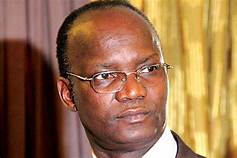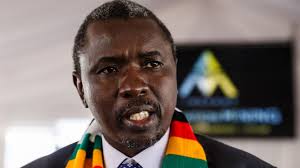KENYA TRIP: Game over for Jonathan Moyo as deep state sources reveal ED Mnangagwa’s plan

Jonathan Moyo
From fierce clashes in the Zanu PF politburo meetings after a bitter political fallout over a hotly contested leadership succession during the late former president Robert Mugabe’s rule to resorting to guns, explosives and thunderflash amid a coup, and tailing by state security agents in a foreign country, this has been the dramatic story of President Emmerson Mnangagwa and his former ally-turned-rival Jonathan Moyo, a mercurial ex-minister now a pain in the neck for him.
“During the liberation war in Mozambique, we used to separate the head from the neck of people like you,” President Emmerson Mnangagwa angrily delivered a chilling warning to former minister Jonathan Moyo at a tense Zanu PF politburo meeting in Harare on 19 July 2017, chaired by the late former president Robert Mugabe.

Moyo had made an audacious and revealing presentation in the politburo, saying Mnangagwa and his faction were capturing state institutions in a plot to oust Mugabe. The plot was pivoted and primed around a document termed Blue Ocean.
The following month, on 9 August 2017, Moyo would say: “After my presentation, Cde Mnangagwa made a shocking statement to the effect that while he was in Mozambique, during the liberation struggle, people who made interventions such as my presentation to the politburo on 19 July would have ‘their head separated from their shoulders’.”
In a letter to former Zanu PF secretary for administration Ignatius Chombo 24 July 2017, Moyo said Mnangagwa’s remarks bordered on a threat to kill him. This would be a running trope leading to the coup and after.
“The full import of Cde Mnangagwa’s statement did not visit me until after the politburo meeting, especially when other politburo members asked me about it,” Moyo wrote to Chombo. “Separating a head from a person’s shoulders is tantamount to murder. The effect of Cde Mnangagwa’s statement was to threaten me with murder and I wish to place this on record and request your office to take the matter under review and to do the needful about it given the serious implications of the unlawful threat.”
Moyo was responding to Chombo’s letter in which he was informed of Mnangagwa’s request for materials used in the presentation against him during the politburo meeting of 19 July.
Besides, Moyo had also privately written to Mugabe warning him that Mnangagwa and his military-backed camp were planning a coup. These events intensified the succession battle and created a volatile political powder keg that would explode anytime.
That was at the height of Mugabe’s explosive succession battle, some months before the military coup that toppled the late authoritarian leader after 37 years in power. The days and months leading to Mugabe’s ouster were uncertain, dramatic and dangerous.
Mnangagwa’s Zanu PF faction was locked in mortal combat with a clique which had coalesced around former first lady Grace Mugabe pushing for defence minister Sydney Sekeramayi to succeed Mugabe in a complex matrix of ambitions and cut-throat political contestation.
After Mnangagwa’s threat, four months down the line, on the day of the military coup in the early hours of 15 November 2017, Moyo’s home in Greystone Park, Harare, would be viciously attacked at night with guns, grenades and explosives as the military takeover which had been loading for months unfolded.
By design, Moyo and his family were not there; they had been forewarned and had sought refuge at former Zanu PF commissar Saviour Kasukuwere’s Glen Lorne home during a night that marked the end of Mugabe’s violent and brutal reign. Mugabe had been warned over the years that his end would be dramatic and tragic given that he ruled by the sword.
Even though Moyo and his family went to hide at Kasukuwere’s home, the army still attacked the monumental house where they huddled together for an uncertain night that was fraught with risk and danger.
That experience seems to have left a horrifying and traumatic impact on Moyo and his family as shown by his tweet on 28 November 2017 pinned on his Twitter platform since 11 December 2018.
Moyo’s tweet says: “What would you do if you and your family survived a 2am 15-minute ZDF (Zimbabwe Defence Forces) attack on your house with seven children, one of them 12 years old, by 25 SAS snipers with semi-automatic weapons; randomly firing tracer bullets and stun grenades? Is this the new justice? New dawn? New era? New Zim?”
Just three weeks earlier, on 6 November, Mugabe had fired Mnangagwa as vice-president, a move that seemed to end his long political career. This forced Mnangagwa to stage a sensational escape through the eastern border into Mozambique before being whisked away from Beira by South African-based Zimbabwean businessman Justice Maphosa’s jet to Pretoria.
From exile in South Africa, where he had been forced to flee for his life, Mnangagwa issued a statement warning Mugabe that he would return “in a matter of weeks” to take control of the levers of power in Zanu PF and government. Many did not believe him. It was a journey fraught with risk and with little guarantee of success.
However, his faction, as well as Zanu PF heavyweights, military commanders, family members, business associates and allies took serious risks to support him, while a nation reeling from a dire economic meltdown and a deep longing for new leadership raised the stakes and demonstrated against Mugabe to salvage a faltering coup.
Mugabe was eventually forced out on 21 November 2017 and, three days later, Mnangagwa was sworn in as new leader. Prior to that, Moyo and Kasukuwere, who had sought refuge at Mugabe’s house during the coup, had staged a mysterious escape from the late president’s mansion and skipped the border into Mozambique before finding their way to Kenya.
Their getaway is now the stuff of legend.
Instead of being cowed by his escape from the jaws of death, Moyo has remained defiant and a thorn in the flesh for Mnangagwa through withering public criticism and attacks.
Four years and four months have gone by since Mnangagwa and military allies hounded Moyo into exile, but the hunt for their political bogeyman has not ended.
Only this week, Mnangagwa’s top priority on his state visit to Kenya was to lobby host President Uhuru Kenyatta to extradite Moyo amid new signs of a deadly political plot to bump him off for continuing to be an unbearable pain in the neck.
One of the biggest attacks Moyo launched on Mnangagwa since he left the country was through the book he wrote about how the 2018 presidential election was stolen.
In his seminal monograph, titled Excelgate – How Zimbabwe’s 2018 Presidential Election was Stolen, Moyo says after taking over the control of the state and its institutions, the military, in a bid to protect and consolidate the gains of the coup, brazenly commandeered the machinery of the Zimbabwe Electoral Commission, particularly its computer network server, corrupted its internal system as well as logistics and illegally changed the route and destination for the collation, compilation and transmission of the result of the 2018 presidential election for purposes of rigging the election in favour of Mnangagwa, whom it had imposed as President of Zimbabwe on 24 November 2017.
That, combined with Moyo’s Twitter war against Mnangagwa and his government, and his historical criticism of him over the Gukurahundi massacres, has left the President seething. This is despite that in 2004 they had worked together to reconfigure the Zanu PF power matrix through the so-called Tsholotsho Declaration that was hatched at the Rainbow Hotel in Bulawayo and was due to be implemented at Dinyane High School in Moyo’s home district of Tsholotsho. The essence of the proposal was to rotate power among ethnic groups in Zimbabwe: Karanga, Ndebele, Manyika and Zezuru.
However, Mugabe and former Zanu PF vice-president Joice Mujuru, supported by her husband the late ex-army commander Solomon Mujuru, had scuttled the ambitious plan that would have changed internal Zanu PF politics largely defined by regional fault-lines, and politicisation and weaponisation of ethnicity.
Mnangagwa left for Nairobi on Tuesday and returned on Thursday on a state visit preceded by the third meeting of the Kenya-Zimbabwe Joint Permanent Commission on Cooperation co-chaired by Foreign Affairs permanent secretary James Manzou who negotiated a number of memoranda of understanding.
Mnangagwa and Moyo worked together in 2004 in a bid to resolve Mugabe’s explosive succession issue, but bitterly fell out after that.
Deep state sources who travelled with Mnangagwa told The NewsHawks that the Zimbabwean President wants Kenyatta to extradite Moyo back home “to face the music”, while an inter-security taskforce continues to hunt him down to arrest or bump him off.
Mnangagwa’s plan was a big ask for Kenyatta who is on his way out in August and is likely to be succeeded by veteran opposition leader Raila Odinga, an ally of main opposition Citizens’ Coalition for Change leader Nelson Chamisa, not the Zimbabwean incumbent.
Kenyatta previously rejected the political extradition request after Moyo, who is married to a Kenyan, fled to Kenya.
Moyo and his former Zanu PF G40 faction colleagues, who were opposed to Mnangagwa’s rise at the zenith of Mugabe’s succession battle, now live in exile as they fear being jailed or killed after surviving night raids and hails of bullets by the army as it shot its way to power.
A deep state source told The NewsHawks: “Zimbabwean state security agents under the cover of the advance team have a mission to hunt Moyo down. Mnangagwa will ask Kenyatta to extradite him, but Zimbabwe has no extradition treaty with Kenya, so a special arrangement would be needed.”
Zimbabwe’s National Prosecuting Authority (NPA) previously wrote to Kenya requesting Moyo’s extradition on corruption allegations linked to accusations that he and four others had allegedly misappropriated U$244 575 from the Zimbabwe Manpower Development Fund.
The plan failed.
The then NPA director, Kumbirai Hodzi, now replaced by his deputy Nelson Mutsonziwa, who was also involved in the mater, had prepared indictment papers for Moyo’s trial in the High Court, but Kenyatta refused, saying it was a political case linked to Zanu PF power struggles and the coup that had removed Mugabe.
Said a security source: “It’s a very serious issue. Remember that our agents previously used the Global Positioning System (GPS) to track his movements via his phone (there is evidence of that); they even texted him his location at a Nairobi hotel where he was having a meeting.
“Second, state agents breached security at his residence in Nairobi and got pictures of him walking into the premises from the CCTV of the complex that he lives in. They then put the photos online to expose and dramatise his security vulnerability.
“Apart from vigorously pushing for his extradition from Kenya, they also sought to put him on the Interpol red list to designate him a wanted man. They further made this public to pressurise him to run away too far from home where he might lose touch or keep quiet to give Mnangagwa relief.
“Meanwhile, the inter-security taskforce has been hunting him down. Further, Hodzi headed another taskforce to Rwanda to find ways from there of bringing him to book. The security taskforce largely comprises CIO, counter-intelligence, military intelligence and police details.
“Beginning this year the security taskforce started exploring ways of seizing Moyo’s properties at home.
Its members from CIO have been harassing chiefs in his rural Tsholotsho home over him since January. They have also sought to politically punish him by several other means.”
Last week, Zimbabwean pastor Walter Magaya was raided by police looking for arms of war at his Mount Pleasant home in Harare soon after returning from a much-hyped crusade in Kenya as Mnangagwa’s regime feared that he had met with Moyo to plot his downfall in the 2023 elections.
Further, Moyo is also a marked man because he is suspected of closely working with Chamisa to oust Mnangagwa in 2023. This has seen Mnangagwa’s government pulling out all the stops to get Moyo by all means.
— NewsHawks






